Consultants Present Recommendations for Scarsdale's Fields and Courts
- Thursday, 24 October 2024 13:36
- Last Updated: Wednesday, 30 October 2024 08:50
- Published: Thursday, 24 October 2024 13:36
- Joanne Wallenstein
- Hits: 2572
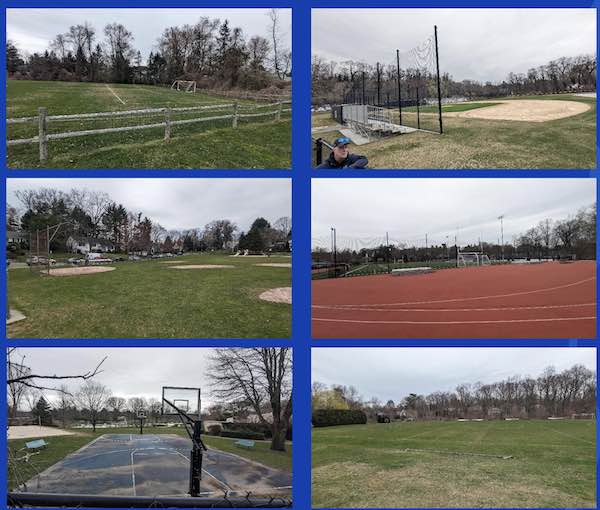 We last heard about a joint field study undertaken by the Village and the Scarsdale Schools in May, 2024. At that time consultants had done a survey of all of Scarsdale’s recreational fields, sites and facilities and were gathering input to prioritize what work should be done first.
We last heard about a joint field study undertaken by the Village and the Scarsdale Schools in May, 2024. At that time consultants had done a survey of all of Scarsdale’s recreational fields, sites and facilities and were gathering input to prioritize what work should be done first.
Drainage, grading, bathrooms and additional fields, both natural and synthetic were all up for discussion.
As a next step in the process, the leadership of the Village and the Schools held an unusual joint “public outreach meeting” at Village Hall on Tuesday October 22 to hear a presentation from consultants CHA. They reviewed their findings to date and presented a series of recommendations to address the issues identified in their study.
Opening the meeting, Mayor Justin Arest repeatedly stressed that “There are no set recommendations now. The next step is to get more feedback and come up with the best plan moving forward with the funds that are available.”
The consultant explained that they had done a complete study of both Village and School owned sites including fields, parks, courts, and the track.
As an outcome of the feedback they received they identified three key themes from the community:
Playability of the existing fields due to wet conditions and drainage
Insufficient capacity and the perception that there is not enough time scheduled for some sports and conflicts in timing between the school and Independent Sport’s Organizations for field time.
Planning and communication including the need for a clear roadmap for implementing improvements, better policies, equitable improvements by sport and gender and last, the noise from pickleball courts.
What did people what to see?
Surveys and feedback identified these themes:
More synthetic fields and new courts, more fields for baseball and softball, more volleyball, basketball and permanent pickleball courts.
Improvements to the existing natural grass fields and courts, including drainage improvements, resurfaced tennis and basketball courts , conversion of elementary school baseball fields to full fields and updated fencing and dugouts.
In addition, respondents asked for lights at one more field, bathrooms or bathroom access, concessions and storage space and equity of field use.
The consultants then provided an analysis of scheduled usage of both the Village and school fields by location and identified shortages in softball, rectangular and baseball field availability. They also provided a comparison of Scarsdale’s field inventory to neighboring towns. Take a look below.
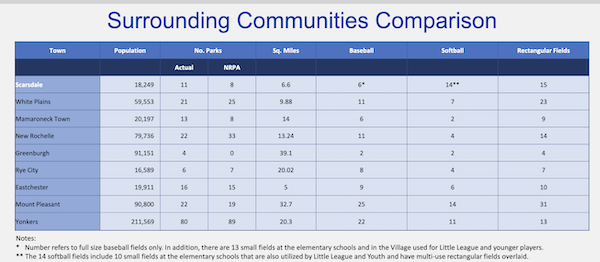
Using this data they presented a series of options to install more synthetic turf fields, construct pickleball courts and basketball courts, improve turf fields, and add parking. They proposed work at Crossway, Boulder Brook, the Middle School and the high school, accompanying each option with an estimated price tag.
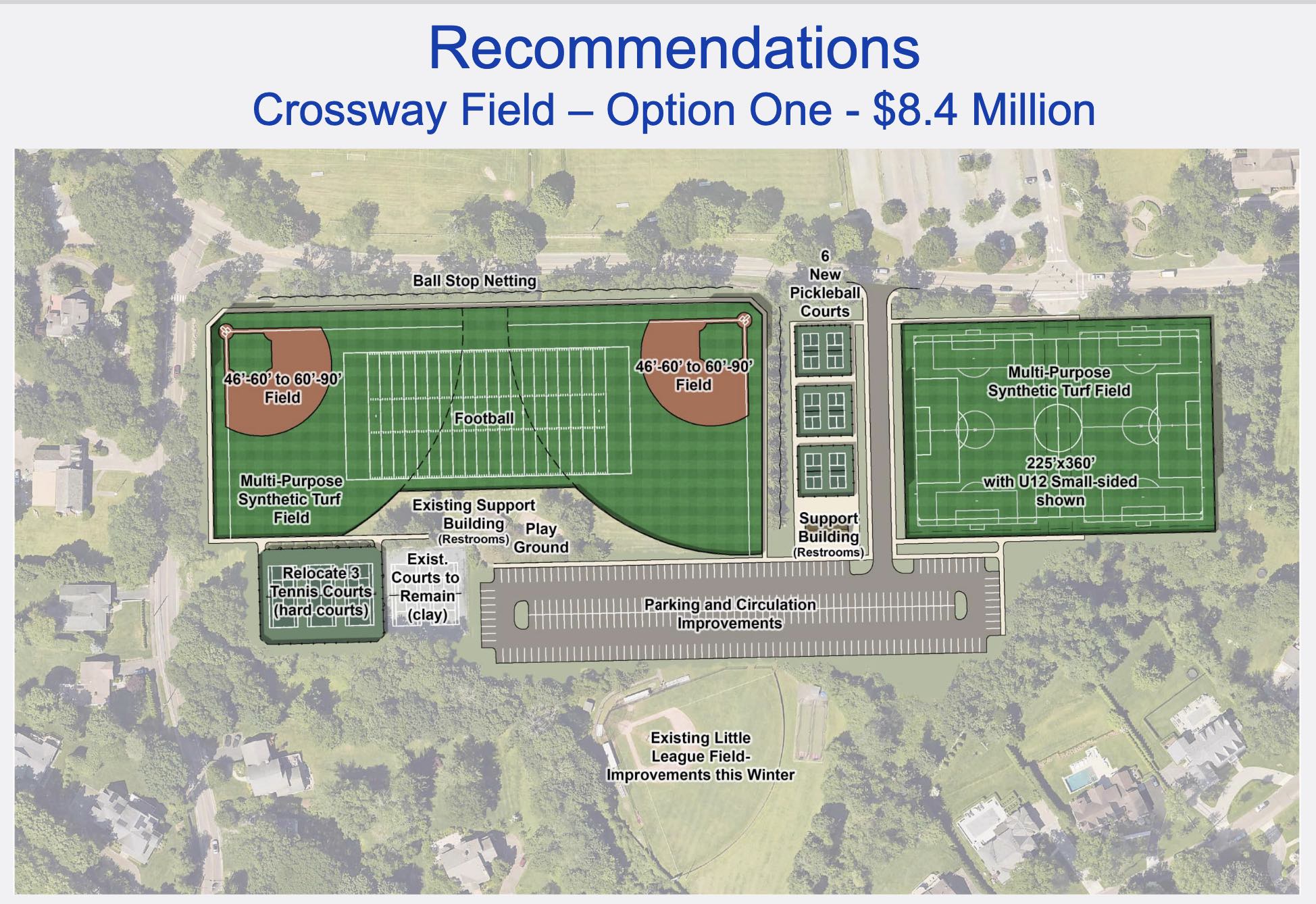
Also included is a list of proposed improvements to “natural” turf including resurfacing tennis courts, adding bleachers, improving drainage, fencing and parking. At several of the elementary schools they proposed field relocations and conversion to full skinned infields.
Overall, the big picture benefits of their proposals include:
-Options for additional synthetic turfs fields for the community on both village and school fields
-Benefits for six field programs: Baseball, Football, Soccer, Softball, Lacrosse and Field Hockey
-Benefits for three court programs: Basketball, Pickleball, and Tennis
Comparing the economics of grass vs. synthetic turf, the consultants showed that though the initial cost to install a synthetic field is double that of a turf field in the long run the maintenance cost for the turf is far lower.
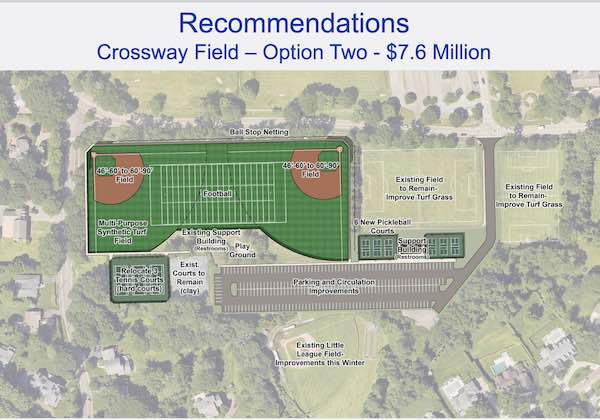
There were many options to sort through and evaluate. Since both the Village and the schools will need to finance the work, both bodies will need to consider these plans in their upcoming budget planning process.
Many turned out to hear the presentation and state their views:
In person and on Zoom there was a mix of opinions – some strongly in favor of building more synthetic fields, others asking the Boards to move swiftly so that their children could benefit from the additional fields and another contingent who voiced concerns about the health and environmental effects of installing synthetic plastic.
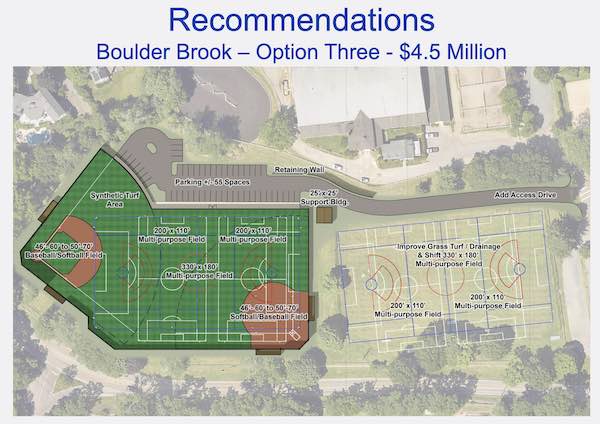
Becky Bach said she “Supported field equity and “fully supports turf.” She said, “I hope this comes to life so that our children can benefit from it. We have experienced many rainouts.
The kids need to get out and play.”
Eric Premisler a Co-President of Scarsdale Youth Soccer Club said, “Athletics is one of the most important things we can give our kids. I am a naturalist – but turf fields are workhorses. We need them. We’re hoping that something comes from this.”
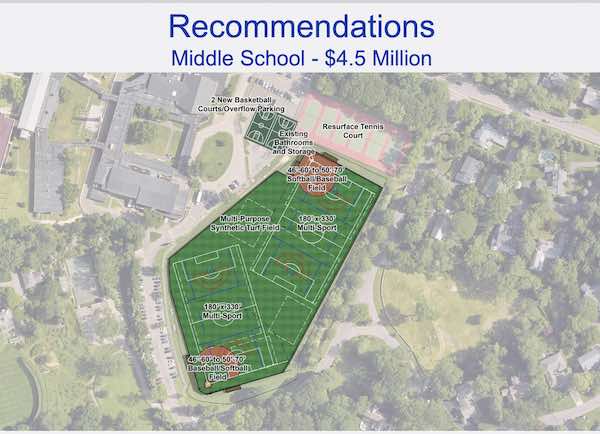
Others said the numbers in the report were not correct:
Diana Gatto who heads Scarsdale Softball corrected the number of fields shown in the report.
Venu Angara said, “The report is not showing actual usage – we should work on the numbers. We need actual numbers for this report to start the analysis.”
Noah Sanders a Co-Chair of SYSC also favored a turf field but asked that the placement be sensitive to the aesthetics of Scarsdale.
Ralph Geer said, “I think it’s high time for this endeavor to take place. I think we should consider adding a dome over one of the fields for winter use – this would maximize field use.”
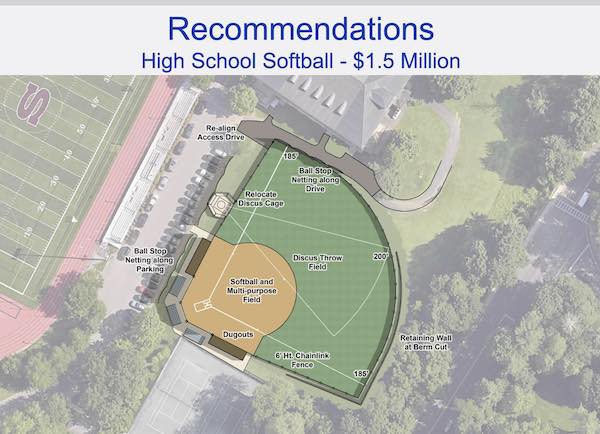
Logan Mancusi who is a Captain of the SHS Baseball Team asked the board to “Try to get the fields open earlier in the season.” He said, “When it rains Dean Field gets shut down. We need better tarps to cover it when it rains so it can be playable the next day.”
Benjamin Hogan, who is an assistant coach of a soccer team suggested that the board provide an FAQ about the timeframe for when these decisions will be made. He said, “We need the fields to be available year-round for kids.”
Claire Paquin favored the use of the field adjacent to the parking at the high school as asked if a full game could be played there? She continued, “How will this be funded so that the burden is not all on the volunteers. This should be bond and budget heavy and private citizens light."
JP Van Arsdale said “I have three kids in high school, middle school and elementary school. I hear the environmental complaints – but the one turf field at the high school has the most activity around it. It shows how important turf can be. This is a must have. Every athlete in the town wants to play on turf.”
Jessica Kourakos said, “We struggle with how often we are rained out of practices and games. We are at a disadvantage compared to other communities. We should take a look at what they are doing in Europe about grass and turf.”
Environmental Concerns:
However there was chorus of those who object to the use of synthetics because it removes permeable surfaces, exacerbates flooding, and poses health concerns for the athletes who play on them.
Rochan Mehta from Deerfield Lane said, “I don’t want to see natural turf converted into synthetic fields. I am in favor of improving drainage rather than adding more plastic to our environment.”
Michelle Sterling said, “Turf causes high heat and off-gassing. It’s a much harder surface as the cushion underneath gets compacted over time. Natural turf is cooler, more cushioned, more sanitary. There are carcinogens from the off gassing and sliding on turf. Though you do get extended playtime, years from now we will think back on this when our kids get cancer. There are also environmental concerns about ripping up the turn every ten years.
Lisa Purcell said, “I am surprised that they are recommending converting grass fields to turf. Other municipalities have banned the use of turf fields. The European Union has also banned crumb rubber. The City of Rye was sued by residents over the installation of artificial turf. Artificial turf does not absorb water and grass does. This is far more expensive than grass. Let’s improve our fields with grading and drainage.”
Darlene LeFrancois Haber introduced herself as a doctor and Chair of the Forum Sustainability Committee. She said, “I am concerned about the installation of turf – I think it would be reckless. I would be happy to download the data on microplastics. I can’t believe were talking about laying this down on turf. I feel like the Village is having an issue with flooding. When you replace this plastic, how do you dispose of this turf? You are adding to a waste stream that you don’t want or need.”
Lori Garfunkel of Lincoln Road was happy to see that the plans for Crossway would move the pickleball courts further from her home. About the current courts she said, “I hear it in my house, in my office and in my bedroom. I would appreciate it if it could be moved further away. It’s over 60 DBA’s. I cannot be outside when it is being played. It is untenable by my home.”
Sarah Bell said, “What about updating the existing fields with drainage, seating and grading? Can we use any part of the pool complex in this plan? I agree with the environmental concerns and health concerns. There is already flooding in Quaker Ridge.”
Trustee Ken Mazer said, “In total, the budget is almost $30 mm. What would be the lowest hanging fruit for the biggest buck?”
Concluding the meeting, Mayor Arest said, “We will post the presentation online and seek additional input from the community. Both Boards will discuss this during budget time.”










